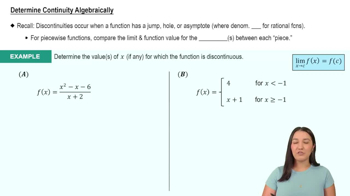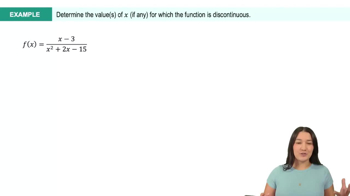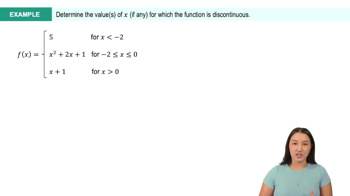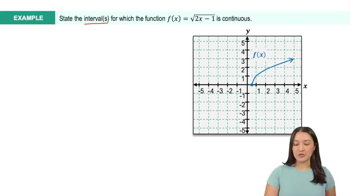Table of contents
- 0. Functions7h 52m
- Introduction to Functions16m
- Piecewise Functions10m
- Properties of Functions9m
- Common Functions1h 8m
- Transformations5m
- Combining Functions27m
- Exponent rules32m
- Exponential Functions28m
- Logarithmic Functions24m
- Properties of Logarithms34m
- Exponential & Logarithmic Equations35m
- Introduction to Trigonometric Functions38m
- Graphs of Trigonometric Functions44m
- Trigonometric Identities47m
- Inverse Trigonometric Functions48m
- 1. Limits and Continuity2h 2m
- 2. Intro to Derivatives1h 33m
- 3. Techniques of Differentiation3h 18m
- 4. Applications of Derivatives2h 38m
- 5. Graphical Applications of Derivatives6h 2m
- 6. Derivatives of Inverse, Exponential, & Logarithmic Functions2h 37m
- 7. Antiderivatives & Indefinite Integrals1h 26m
1. Limits and Continuity
Continuity
Problem 2.6.25
Textbook Question
Textbook QuestionDetermine the interval(s) on which the following functions are continuous.
p(x)=4x^5−3x^2+1
 Verified Solution
Verified SolutionThis video solution was recommended by our tutors as helpful for the problem above
Video duration:
2mPlay a video:
Was this helpful?
Key Concepts
Here are the essential concepts you must grasp in order to answer the question correctly.
Continuity of Functions
A function is continuous at a point if the limit of the function as it approaches that point equals the function's value at that point. For a function to be continuous over an interval, it must be continuous at every point within that interval. This means there are no breaks, jumps, or asymptotes in the function's graph.
Recommended video:

Intro to Continuity
Polynomial Functions
Polynomial functions, like p(x) = 4x^5 - 3x^2 + 1, are continuous everywhere on the real number line. This is because they are composed of terms that are powers of x with real coefficients, which do not introduce any discontinuities. Understanding the nature of polynomial functions is crucial for determining their continuity.
Recommended video:
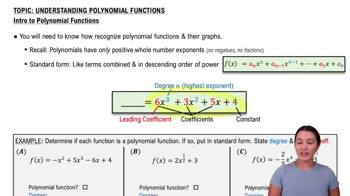
Introduction to Polynomial Functions
Intervals of Continuity
Intervals of continuity refer to the ranges of x-values over which a function remains continuous. For polynomial functions, the interval of continuity is typically all real numbers, denoted as (-∞, ∞). Identifying these intervals involves analyzing the function's behavior and ensuring it meets the criteria for continuity across the specified range.
Recommended video:
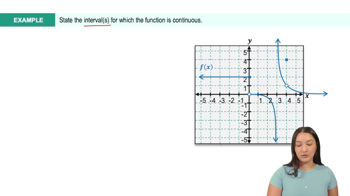
Intro to Continuity Example 1
Related Videos
Related Practice




